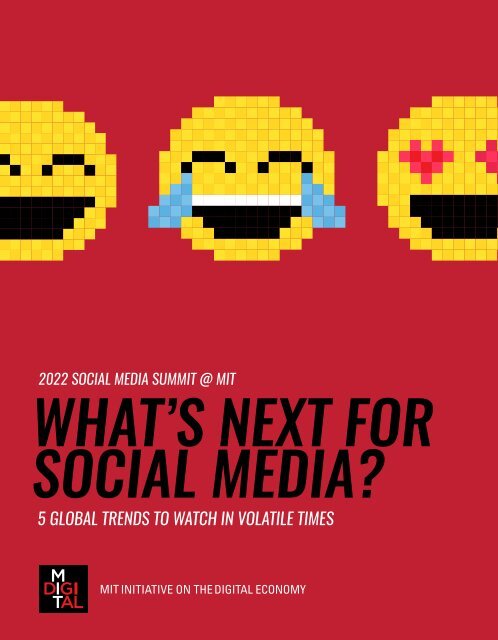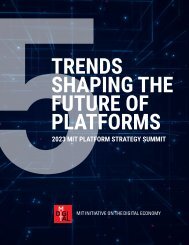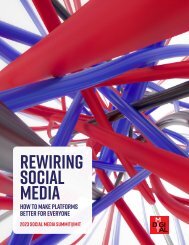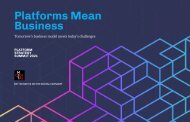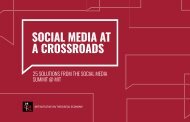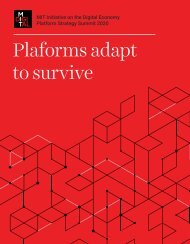The 2022 Social Media Summit@MIT Event Report
You also want an ePaper? Increase the reach of your titles
YUMPU automatically turns print PDFs into web optimized ePapers that Google loves.
<strong>2022</strong> SOCIAL MEDIA SUMMIT @ MIT<br />
WHAT’S NEXT FOR<br />
SOCIAL MEDIA?<br />
5 GLOBAL TRENDS TO WATCH IN VOLATILE TIMES
SOCIAL MEDIA SUMMIT @ MIT <strong>2022</strong><br />
A MINEFIELD OF<br />
ONLINE VOLATILITY<br />
<strong>The</strong> second annual <strong>Social</strong> <strong>Media</strong> <strong>Summit@MIT</strong> focused on the information<br />
war in Ukraine, fake news, the need for greater algorithmic<br />
transparency, and the importance of ethics in artificial intelligence.<br />
“It’s extremely important to keep the conversation going,<br />
and that’s exactly what we intend to do.”<br />
SINAN ARAL<br />
<strong>The</strong> <strong>Social</strong> <strong>Media</strong> <strong>Summit@MIT</strong> (SMS),<br />
hosted by MIT’s Initiative on the Digital<br />
Economy (IDE), was launched last year in the<br />
midst of unprecedented upheavals sparked<br />
and organized on social media platforms—<br />
including the January 6, 2021, storming of the<br />
U.S. Capitol. And the turmoil didn’t stop there.<br />
In February, former President Donald Trump<br />
launched his own social media platform,<br />
Truth <strong>Social</strong>, after he was permanently<br />
banned from Twitter and suspended from<br />
Facebook for two years. In another shakeup,<br />
<strong>The</strong> Wall Street Journal published “<strong>The</strong><br />
Facebook Papers,” a damning, multipart<br />
report based on more than 10,000 documents<br />
leaked by a company whistleblower.<br />
We’re less than halfway into <strong>2022</strong>, yet already<br />
it’s shaping up to be another pivotal year for<br />
social media, where we are witnessing Russia’s<br />
brutal invasion of Ukraine with both real bombs<br />
and fake news.<br />
All of these developments resonated during<br />
the <strong>2022</strong> SMS event—in particular, in a<br />
conversation between IDE Director Sinan Aral<br />
and the Facebook whistleblower, Frances<br />
Haugen (see details, page 4). Calls for more<br />
transparency from platform companies and<br />
algorithm designers were dominant throughout<br />
the day. Since the event, Twitter became a<br />
takeover target by Elon Musk.<br />
Discussions focused on the pressing<br />
concerns of misinformation amplified by<br />
social media and how to achieve the goals of<br />
AI and algorithmic transparency and ethics.<br />
Panels were led by top MIT researchers—<br />
David Rand, Dean Eckles, and Renée<br />
Richardson Gosline—who, according to<br />
Aral, are engaged in “groundbreaking<br />
research that is making meaningful inroads<br />
into solving the social media crisis.”<br />
<strong>The</strong> moderators were joined by a diverse<br />
group of academics, social media pros, a<br />
state senator, and others, providing a rich<br />
day of contrasting views and opinions. One<br />
obvious trend is that social media’s clout is<br />
growing, and so is its scrutiny. “It’s extremely<br />
important to keep the conversation going,”<br />
Aral told SMS attendees, “and that’s exactly<br />
what we intend to do.”<br />
03 OVERVIEW<br />
04 FIRESIDE CHAT WITH FRANCES HAUGEN<br />
08 MISINFORMATION AND FAKE NEWS<br />
12 ALGORITHMIC TRANSPARENCY<br />
16 THE INFORMATION WAR IN UKRAINE<br />
20 RESPONSIBLE AI<br />
24 FINAL THOUGHTS & THANKS<br />
Click the play icon throughout<br />
the report to view session videos<br />
On March 31, <strong>2022</strong>, MIT’s Initiative on the<br />
Digital Economy (IDE) hosted the second<br />
annual <strong>Social</strong> <strong>Media</strong> Summit (SMS@MIT).<br />
<strong>The</strong> online event, which attracted more<br />
than 12,000 virtual attendees, convened<br />
technology and policy experts to examine<br />
the growing impact of social media on our<br />
democracies, our economies, and our public<br />
health—with a vision to craft meaningful<br />
solutions to the growing social media crisis.<br />
5 GLOBAL TRENDS<br />
1<strong>Social</strong><br />
media’s<br />
impact on<br />
child<br />
and adult<br />
psychology2<br />
<strong>The</strong> threat<br />
of online<br />
misinformation<br />
and<br />
the need<br />
for systemic<br />
solutions<br />
<strong>The</strong> importance<br />
of<br />
algorithmic<br />
transparency<br />
—and how to<br />
3achieve it<br />
Expansion<br />
of social<br />
media’s<br />
impact on<br />
geopolitics<br />
4and war<br />
<strong>The</strong> formalization<br />
of AI ethics<br />
standards<br />
and 5training<br />
2<br />
3
FIRESIDE CHAT SOCIAL MEDIA SUMMIT @ MIT <strong>2022</strong><br />
FRANCES HAUGEN<br />
SPEAKS OUT<br />
<strong>The</strong> Facebook whistleblower says the company must acknowledge its<br />
tremendous impact and become more transparent.<br />
Frances Haugen is a former<br />
Facebook algorithmic product<br />
manager who today is better<br />
known as the company’s chief<br />
whistleblower. She joined Sinan<br />
Aral to discuss Facebook’s<br />
impact on society, how the<br />
company has resisted efforts to<br />
analyze its algorithms, and what<br />
actions it can take in the future.<br />
Haugen, who earned an MBA<br />
from Harvard Business School<br />
and worked as an electrical<br />
engineer and data scientist<br />
before joining Facebook in<br />
2019, said no one intends to<br />
be a whistleblower. “Living with<br />
a secret is really, really hard;<br />
especially when you think that<br />
secret affects people’s health,<br />
their lives, and their well-being,”<br />
she said.<br />
That’s why Haugen said she<br />
left the company in 2021 and<br />
provided more than 10,000<br />
internal documents to <strong>The</strong><br />
Wall Street Journal. <strong>The</strong>se<br />
documents became the basis<br />
for the newspaper’s series, “<strong>The</strong><br />
Facebook Files.” As the Journal<br />
wrote, “Facebook knows, in acute<br />
detail, that its platform is riddled<br />
Frances<br />
Haugen<br />
provided<br />
more than<br />
10,000<br />
internal<br />
Facebook/<br />
Meta<br />
documents<br />
to the<br />
press.<br />
with flaws that cause harm,<br />
often in ways only the company<br />
fully understands.”<br />
One of Haugen’s biggest<br />
criticisms of Facebook, which<br />
was renamed Meta in 2021,<br />
concerns the way the company<br />
has, in her opinion, conflated<br />
the issues of censorship and<br />
algorithmic reach. Most social<br />
media critics say that algorithms<br />
promote dangerous and extreme<br />
content such as hate speech,<br />
vaccine misinformation, and<br />
poor body image messaging to<br />
young people.<br />
Yet Facebook has been quick<br />
to frame the issue as one of<br />
censorship and free speech—not<br />
its proprietary algorithms, Haugen<br />
said. For example, the remit of the<br />
company’s Oversight Board, of<br />
which Haugen was a member, is<br />
to censor those who don’t comply<br />
with content policies. This charter,<br />
Haugen noted, is deliberately<br />
narrow. “Facebook declined to ever<br />
let us discuss the non-contentbased<br />
ways we could be dealing<br />
with safety problems”–such as<br />
building in some “pause” time<br />
before someone can share a link.<br />
“It sounds like a really small thing,<br />
but it’s the difference of 10% or<br />
15% of [shared] misinformation,”<br />
she said. “That little bit of friction,<br />
giving people a chance to breathe<br />
before they share, has the same<br />
impact as the entire third-party<br />
fact-checking system.”<br />
Aral agreed that there is a gap<br />
“between free speech and<br />
algorithmic reach,” and that<br />
fixing one doesn’t infringe on the<br />
other. He pointed to MIT research<br />
showing that when social-media<br />
users pause long enough to think<br />
critically, they’re less likely to<br />
spread fake news. “It’s a cognitive,<br />
technical solution that has<br />
nothing to do with [free] speech,”<br />
Aral said.<br />
Kids and <strong>Social</strong> <strong>Media</strong><br />
Haugen also described the<br />
disturbing ways social media<br />
and targeted advertising affect<br />
teens and children. For example,<br />
Facebook’s surveys, some<br />
involving as many as 100,000<br />
respondents, found that socialmedia<br />
addiction—euphemistically<br />
known as “problematic use”—is<br />
most common among 14-yearolds.<br />
Yet when <strong>The</strong> Wall Street<br />
Journal gave Facebook a chance<br />
to respond to these findings, the<br />
company pointed to other surveys<br />
with smaller sample sizes and<br />
different results.<br />
“I can tell you as an algorithm<br />
specialist that these algorithms<br />
concentrate harms...in the form of<br />
vulnerability,” Haugen said. “If you<br />
have a rabbit hole you go down,<br />
they suck you toward that spot.<br />
Algorithms don’t have context.<br />
<strong>The</strong>y don’t know if a topic is good<br />
for you or bad for you. All they<br />
know is that some topics really<br />
draw people in.”<br />
Unfortunately, that often means<br />
more extreme content gets the<br />
most views. “Put in ‘healthy eating’<br />
on Instagram,” she said, “and in the<br />
course of a couple of weeks, you<br />
end up [with content] that glorifies<br />
eating disorders.” (Meta has owned<br />
Instagram since 2012.)<br />
She’d like to see legislation to<br />
keep children under 13 off most<br />
social media platforms. Meta<br />
documents show that 20% of<br />
11-year-olds are on the platform.<br />
She’d also like adults to have<br />
the option to turn off targeted<br />
ads. Similarly, she would like to<br />
see a ban on targeted ads, such<br />
as those for weight loss<br />
supplements aimed at children<br />
and teens under the age of 16.<br />
Haugen also suggested that<br />
Facebook dedicate more resources<br />
to fighting misinformation, fake<br />
news, and hate speech. “We need<br />
flat ad rates,” she said. “Facebook’s<br />
own research has said over and<br />
over again that the shortest path<br />
to a click is hate, is anger. And so<br />
it ends up that angry, polarizing,<br />
divisive ads are five to 10 times<br />
cheaper than compassionate or<br />
empathetic ads.”<br />
“If we want to be safe,” Haugen<br />
concluded, we need to have<br />
open conversations about<br />
these practices and “invest<br />
more on transparency.”<br />
3 WAYS<br />
TO FIX<br />
FACEBOOK<br />
Ban targeted ads to<br />
children under 16<br />
Dedicate more<br />
resources to fight<br />
fake news and hate<br />
speech<br />
Keep kids under 13<br />
off the platform<br />
“Living with a<br />
secret is really,<br />
really hard,<br />
especially when<br />
you think that<br />
secret affects<br />
people's health,<br />
their lives and<br />
their well-being.”<br />
FRANCES HAUGEN<br />
4<br />
5
FIRESIDE CHAT SOCIAL MEDIA SUMMIT @ MIT <strong>2022</strong><br />
6<br />
7
PANEL : MISINFORMATION SOCIAL MEDIA SUMMIT @ MIT <strong>2022</strong><br />
FAKE NEWS,<br />
REAL IMPACT<br />
Is social media to blame for producing<br />
and spreading misinformation—or is it<br />
part of a broader problem?<br />
David Rand Professor, MIT Sloan, MIT IDE group leader<br />
Renée DiResta Research Manager, Stanford Internet Observatory<br />
Rebecca Rausch Massachusetts State Senator<br />
Duncan Watts Professor, University of Pennsylvania<br />
Fake news and misinformation<br />
headlines are rampant: <strong>The</strong> presidential<br />
election was stolen. Vaccinations kill.<br />
Climate change is a hoax. To what<br />
extent is social media responsible?<br />
That was the critical question raised by<br />
expert panelists in the second session<br />
of SMS@MIT <strong>2022</strong>.<br />
<strong>The</strong> dangers are undoubtedly real,<br />
but Duncan Watts, Stevens University<br />
Professor at the Annenberg School<br />
for Communications at the University<br />
of Pennsylvania, observed that<br />
social media is one small cog in a<br />
larger set of mass media gears. “For<br />
the average American, the fraction<br />
of fake news in their media diet is<br />
extremely low,” he argued.<br />
Research shows that most Americans<br />
still get their news primarily from<br />
television. And of the news they do<br />
consume online, fake news represents<br />
only about 1% of the total. “We need<br />
to look much more broadly than<br />
social media,” Watts said. “We need<br />
to look across all types of platforms<br />
and content” to determine the source<br />
of fake news. Today, there are<br />
interconnected ecosystems—from<br />
online influencers to cable networks<br />
and print media—that all contribute to<br />
amplifying misinformation.<br />
Small Groups, Big Impacts<br />
Fellow panelist Renée DiResta,<br />
research manager at Stanford Internet<br />
Observatory, maintained that even small<br />
groups of people spreading fake news<br />
and misinformation can have outsized<br />
reach and engagement online.<br />
“<strong>The</strong> literal definition of the word<br />
propaganda means to propagate,<br />
the idea that information must be<br />
propagated,” she said. “And social<br />
media is a phenomenal tool for this,<br />
particularly where small numbers of<br />
people can propagate and achieve<br />
very, very significant reach in a way<br />
that they couldn’t in old broadcast<br />
media environments that were much<br />
more top-down.”<br />
Specifically, DiResta explained<br />
how information goes viral and<br />
echo chambers arise. “Influencers<br />
have an amplification network,<br />
the hyper-partisan media outlet<br />
has an amplification network, until<br />
[misinformation] winds up being<br />
discussed on the nightly news,”<br />
she said. “And it’s a phenomenally<br />
distinct form of creating what is<br />
effectively propaganda...it’s just<br />
this fascinating dynamic that we<br />
see happening with increasing<br />
frequency over the last few years.”<br />
Research upholds the idea that<br />
familiarity with a topic “cues”<br />
our brains for accuracy. In other<br />
words, the more often you hear an<br />
assertion—whether true, false or<br />
neutral—the more likely you are to<br />
believe it, according to moderator<br />
David Rand, MIT professor of<br />
management science and brain<br />
and cognitive sciences, and a<br />
group leader at the IDE.<br />
Healthcare’s Unhealthy Messages<br />
This repetition of false news<br />
is “massively problematic” for<br />
the public, said Massachusetts<br />
State Senator Rebecca Rausch.<br />
As an example, she cited reports<br />
stating that 147 of the leading<br />
anti-vaccination feeds, mainly on<br />
Instagram and YouTube, now have<br />
more than 10 million followers, a<br />
25% increase in just the last year.<br />
“A number of anti-vax leaders<br />
seized the COVID-19 pandemic<br />
as a historic opportunity to<br />
popularize anti-vaccine sentiment,”<br />
Rausch said. One result, she said,<br />
is that vaccination hesitancy is<br />
now rising, even for flu and other<br />
routine shots.<br />
Rausch also cited reports that<br />
say 12 anti-vaccination sources<br />
are responsible for 65% of all<br />
anti-vax content online. Some<br />
people also profit from their<br />
misinformation by selling pills and<br />
other supplements they claim<br />
can act as vaccine alternatives.<br />
Watts agreed that “small groups<br />
of people with extreme points of<br />
view and beliefs can indeed inflict<br />
disproportionate harm on society.”<br />
But, rather than saying, “we’re<br />
all swimming in this sea of<br />
misinformation and there’s some<br />
large average effect that is being<br />
applied to society,” we should be<br />
looking at the broader context,<br />
he said.<br />
Algorithmic Influences<br />
Watts said that people often<br />
seek out certain content by<br />
choice. “It’s not necessarily that<br />
the platform is driving people into<br />
a particular extreme position,”<br />
he said. Evidence based on<br />
YouTube, for example, shows<br />
there is a lot of user demand<br />
driving traffic—people search<br />
for specific content, find it, and<br />
share it widely. Unfortunately,<br />
he said, “It’s shocking to be<br />
confronted with that, but it’s not<br />
necessarily a property of the<br />
social media platform.”<br />
Yet DiResta said we can’t<br />
underestimate algorithmic<br />
influence. “<strong>The</strong>re’s an expression:<br />
‘We shape our systems; thereafter,<br />
they shape us,’” DiResta said.<br />
“We’re seeing the extent to which<br />
the network is shaped by the<br />
platform’s incentives.”<br />
Both DiResta and Rausch believe<br />
some of the solutions rest with<br />
legislation. But Rausch asked at<br />
what point laws can supersede<br />
algorithms that promote fringe<br />
content. “What should we be<br />
changing, if anything?” she asked.<br />
“We are very far from knowing<br />
what policies should be proposed<br />
in terms of changing social<br />
media, like platform behavior,<br />
and regulating it,” said Rand.<br />
“But we really need policy around<br />
transparency and making data<br />
available, breaking down the<br />
walled gardens so people from the<br />
outside can learn more about what<br />
is going on.”<br />
For Watts, solutions are complex:<br />
“We can’t go back to a world where<br />
we don’t have the technology to<br />
communicate in this way...and it’s<br />
not at all clear that you can say,<br />
‘Well, you guys can talk to each<br />
other about cargo bikes [online],<br />
but you can’t talk to each other<br />
about vaccines.’ I don’t deny that<br />
it’s a terrible problem, but I feel<br />
very conflicted about how we think<br />
about solutions.”<br />
FACT CHECK<br />
1 %<br />
of online content<br />
is fake news<br />
12<br />
sources are<br />
responsible for 65%<br />
of anti-vax content<br />
10mil<br />
people follow top<br />
anti-vax news feeds<br />
8<br />
9
PANEL : MISINFORMATION SOCIAL MEDIA SUMMIT @ MIT <strong>2022</strong><br />
10<br />
11
PANEL : TRANSPARENCY<br />
SOCIAL MEDIA SUMMIT @ MIT <strong>2022</strong><br />
SEEING THROUGH<br />
SOCIAL MEDIA<br />
ALGORITHMS<br />
<strong>The</strong> software that drives social media<br />
is top secret. But given platforms’<br />
huge impact on society, should social<br />
media companies provide greater<br />
algorithmic transparency?<br />
Dean Eckles Assistant Professor, MIT Sloan, MIT IDE group leader<br />
Daphne Keller Director of Platform Regulation, Stanford University<br />
Kartik Hosanagar Professor, <strong>The</strong> Wharton School<br />
“Simply gaining<br />
access to<br />
social media<br />
algorithms isn’t<br />
the complete<br />
answer.”<br />
DEAN ECKLES<br />
“Algorithmic transparency”<br />
may not be an everyday phrase,<br />
but what’s behind it is simple<br />
enough: <strong>Social</strong> media platforms,<br />
including Facebook, Twitter,<br />
and YouTube, are having such<br />
a significant impact on society,<br />
researchers should be allowed<br />
to study the software programs<br />
that drive their recommendation<br />
engines, content rankings, feeds<br />
and other processes.<br />
Transparency was a common<br />
theme throughout the day, but<br />
one session at SMS@MIT <strong>2022</strong>,<br />
focused entirely on the topic,<br />
digging deep into how the goal<br />
can be achieved, and what the<br />
tradeoffs may be. Panelists<br />
explained that many social<br />
media companies have treated<br />
their software code as a state<br />
secret to date. Access to<br />
proprietary algorithms is granted<br />
to company insiders only—and<br />
that’s a problem in terms of<br />
verifying and testing the platforms<br />
and their content.<br />
“Platforms have too much<br />
control,” said Kartik Hosanagar,<br />
professor of operations,<br />
information, and decisions at <strong>The</strong><br />
Wharton School, referring to the<br />
relationship between algorithmic<br />
transparency and user trust.<br />
“Exposing that [information] to<br />
other researchers,” he added, “is<br />
extremely important.”<br />
Complex Interactions<br />
At the same time, simply gaining<br />
access to social media algorithms<br />
isn’t sufficient, said Dean Eckles,<br />
the panel’s moderator and an<br />
associate professor of marketing<br />
at MIT Sloan School. He said his<br />
own research shows “how hard it<br />
is to quantify some of the impacts<br />
of algorithmic ranking,” such as<br />
bias and harm.<br />
Eckles noted that algorithms and<br />
consumers are in a feedback loop.<br />
<strong>The</strong>re is an interdependence of<br />
sorts “because the algorithms<br />
are responding to user choices,<br />
and then users are making<br />
choices based on the algorithm.”<br />
Hosanagar added, “It’s a very<br />
complex interaction. It isn’t<br />
that one particular choice of<br />
algorithm always increases or<br />
always decreases filter bubbles.<br />
It also depends on how users<br />
respond.” <strong>The</strong> narrative that<br />
algorithms cause the filter bubble<br />
is too simple, he said, adding, “it’s<br />
far more nuanced than that.”<br />
Daphne Keller, director of the<br />
Program on Platform Regulation<br />
at Stanford University’s Cyber<br />
Policy Center, would like to see<br />
more academic research into<br />
how social media platforms<br />
moderate and amplify content<br />
and what sorts of content<br />
control—such as taking down<br />
offensive or false posts—their<br />
terms of service permit.<br />
Unfortunately, “data scientists<br />
inside the platform have all of<br />
this [information],” Keller said.<br />
“Lots of people outside platforms<br />
have really compelling arguments<br />
about the good they can do in the<br />
world if they had that access. But<br />
we have to navigate those really<br />
significant barriers and competing<br />
values.” Opening APIs to other<br />
data scientists—as they are doing<br />
in the EU—would be a helpful start<br />
to more transparency. According<br />
to panelists, less clear is what<br />
data access consumers would<br />
want or use.<br />
Political Power<br />
<strong>The</strong> panel also discussed the<br />
difficulty of learning the exact<br />
impact of social media on politics.<br />
As Hosanagar—and Frances<br />
Haugen, formerly of Facebook—<br />
pointed out, the public sees<br />
only reports the social media<br />
companies make public. “We don’t<br />
BREAKING<br />
THE CODE<br />
1<br />
Most<br />
2<br />
3<br />
<strong>Social</strong><br />
platform<br />
companies continue<br />
to treat their<br />
algorithms as<br />
classified secrets.<br />
Greater access<br />
to social media<br />
algorithms would<br />
allow researchers<br />
to explore<br />
platforms’ impacts<br />
and intentions.<br />
media<br />
companies might<br />
share their<br />
code if offered<br />
incentives.<br />
know about the ones that are not<br />
approved internally,” he explained.<br />
Keller added: “We need to have<br />
researchers and algorithm<br />
experts try to figure out a ranked<br />
list of priorities because we’re not<br />
going to get everything.”<br />
One way forward without stifling<br />
innovation, Eckles suggested,<br />
would be to incentivize social<br />
media firms to share their<br />
internal data with other<br />
researchers. Those incentives<br />
could include public pressure and<br />
the threat of lawsuits. It’s already<br />
happened with Facebook sharing<br />
data with <strong>Social</strong> Science One,<br />
an independent research<br />
commission formed to study<br />
the effects of social media on<br />
elections—potentially a sign of<br />
good things to come.<br />
12<br />
13
PANEL : TRANSPARENCY SOCIAL MEDIA SUMMIT @ MIT <strong>2022</strong><br />
14<br />
15
PANEL : INFOWARS<br />
SOCIAL MEDIA SUMMIT @ MIT <strong>2022</strong><br />
UKRAINE’S SECOND<br />
BATTLEFIELD:<br />
INFORMATION<br />
While Russia’s military invasion of Ukraine<br />
involves all-too-real soldiers, guns, and<br />
tanks, the two nations are also fighting a<br />
war of information. <strong>The</strong>ir main weapon of<br />
choice? <strong>Social</strong> media.<br />
Sinan Aral Director, MIT IDE<br />
Clint Watts Distinguished Research Fellow, Foreign Policy Research Institute<br />
Richard Stengel Political Analyst, CNBC<br />
Natalia Levina Professor, NYU Stern School of Business<br />
WAR OF WORDS<br />
In Ukraine, social media<br />
is being enlisted for<br />
grassroots organizing<br />
and assistance.<br />
<strong>The</strong> most widely used<br />
social media platforms<br />
include Telegram and<br />
TikTok.<br />
Video is the most popular<br />
format for social<br />
media during the war.<br />
<strong>The</strong>re was nothing fake about<br />
Russia’s military assault on<br />
Ukraine on February 24, <strong>2022</strong>.<br />
Soldiers attacked the country<br />
with guns, tanks, and bombs,<br />
and the war still rages. But<br />
on a second front—a parallel<br />
information war waged via social<br />
media—the most dangerous<br />
weapons were misinformation<br />
and fake news, said IDE director<br />
Sinan Aral as he introduced his<br />
expert panelists.<br />
Without downplaying the severity<br />
of the violence committed<br />
by Russia’s military against<br />
Ukrainian civilians, panelists<br />
considered the implications of<br />
the shadow information war in<br />
Ukraine, as well as how both<br />
sides are using social media to<br />
rally global support and spread<br />
information and disinformation.<br />
Natalia Levina, professor of<br />
information systems at NYU’s<br />
Stern School of Business, who<br />
grew up in Ukraine’s secondlargest<br />
city, Kharkiv, said, “My<br />
day often starts with looking<br />
[online] at what’s going on in<br />
Kharkiv. And every day, I hope the<br />
bombardment of the city is less.”<br />
Russia’s designs on Ukraine<br />
date back to at least 2014, the<br />
year Russia annexed Crimea.<br />
Panelist Richard Stengel, a<br />
CNBC analyst and former U.S.<br />
undersecretary of state, said<br />
that’s also when Russia launched<br />
an early and intense information<br />
war. At the time, Russian<br />
President Vladimir Putin denied<br />
the very existence of the invasion,<br />
even after Russian troops had<br />
crossed the border. Other Russian<br />
propaganda disseminated on<br />
social media and elsewhere<br />
falsely accused Ukrainians of<br />
being antisemitic Nazis.<br />
Eight years later, the situation has<br />
shifted. This time, Stengel said,<br />
Russia’s propaganda on social<br />
media appears “antiquated,”<br />
“clunky,” and “uncreative.” That’s<br />
surprising, he said, since the<br />
Russians follow a strategy stating<br />
that four-fifths of war is not<br />
kinetic but information. “<strong>The</strong>y<br />
have a sophisticated 30,000-foot<br />
view,” Stengel said, but they don’t<br />
seem to be executing it.<br />
Levina was less sanguine,<br />
saying, “it’s unfortunately<br />
premature to say that Ukraine<br />
has won the information war.”<br />
Russia is disseminating its<br />
messages via TikTok and its<br />
own state-run media.<br />
Video, Telegram Rule<br />
TikTok and video have emerged<br />
as top weapons in this new<br />
information war, explained Clint<br />
Watts, a research fellow at the<br />
Foreign Policy Research Institute.<br />
“Video is king now across all<br />
platforms,” he said. “Over the<br />
last decade, video-enabled<br />
social media has become much<br />
more available and ubiquitous…<br />
everybody has a camera.”<br />
Watts added that President<br />
Volodymyr Zelensky, a<br />
former actor, is a good video<br />
communicator. In addition,<br />
Zelensky and his government<br />
have used the power of platforms<br />
to crowdsource a virtual army.<br />
While Ukraine doesn’t have many<br />
physical resources, Watts said, it<br />
has a “worldwide audience that<br />
wants to help,” including people<br />
to fight, provide materials and<br />
donate through cryptocurrencies,<br />
and more. “A decade ago, we<br />
were talking about Twitter as<br />
the distribution platform,” Watts<br />
added. “<strong>The</strong> information battle<br />
today is on Telegram.”<br />
At the same time, false videos<br />
are proliferating in Russia and in<br />
China—the latter, home of TikTok.<br />
As Aral noted, the messaging app<br />
Telegram, which is widely<br />
used in both Ukraine and<br />
Russia, is owned by a Russian<br />
who opposes moderating or<br />
removing disinformation from<br />
Russia or elsewhere.<br />
“<strong>The</strong>re is a ton to learn from<br />
what’s happening right now<br />
that would be instructive for<br />
democracies,” Watts said.<br />
“All our norms around how<br />
state conflicts run will change<br />
because this is the first social<br />
media-powered state conflict<br />
I’ve seen.”<br />
For example, he said, Ukrainian<br />
soldiers are essentially<br />
conducting psychological<br />
operations on their adversary by<br />
directly text messaging soldiers<br />
on the front lines. “This is<br />
remarkable,” Watts added.<br />
Reviving Personal Networks<br />
<strong>Social</strong> media is also being used<br />
for positive ends. For example,<br />
Levina uses social media to<br />
check in with Ukrainian relatives,<br />
some of whom were too old or<br />
ill to evacuate.<br />
Levina said that social media<br />
is also reviving old-fashioned<br />
personal networks within the<br />
greater Ukrainian community.<br />
“Somebody on Facebook—a<br />
friend of a friend—may say,<br />
‘We know that people in this<br />
hospital...really need catheters,’”<br />
she said. “So everybody in the<br />
network is looking for medical<br />
catheters of a particular size that<br />
would then be shipped.” This kind<br />
of strong, grassroots organizing<br />
has been “amazing,” Levina said.<br />
Still, Levina called for continued<br />
vigilance. “We have to be active<br />
skeptics, not cynics,” she said.<br />
“We really need to keep checking<br />
the information and not be lazy.”<br />
In the new information war, that’s<br />
a powerful command.<br />
16<br />
17
PANEL : INFOWARS SOCIAL MEDIA SUMMIT @ MIT <strong>2022</strong><br />
18<br />
19
PANEL : RESPONSIBLE AI SOCIAL MEDIA SUMMIT @ MIT <strong>2022</strong><br />
WHO’S<br />
RESPONSIBLE<br />
FOR<br />
IRRESPONSIBLE<br />
AI?<br />
Software does whatever it’s programmed to<br />
do. <strong>The</strong> primary factor behind AI ethics is<br />
the people who design and create it.<br />
Renée Richardson Gosline Professor, MIT Sloan, MIT IDE group leader<br />
Rumman Chowdhury Director, Twitter<br />
Chris Gilliard Professor, Macomb Community College<br />
Suresh Venkatasubramanian Asst. Director, U.S. Office of Science and Technology Policy<br />
<strong>The</strong> talk about artificial intelligence<br />
(AI) being ethical and responsible<br />
can be a bit misleading. Software<br />
itself is neither ethical nor<br />
responsible; it does what it’s been<br />
programmed to do. <strong>The</strong> greater<br />
concern is the people behind<br />
the software. Unfortunately, said<br />
panelists in this SMS@MIT <strong>2022</strong><br />
session, the ethics of many AI<br />
developers and their companies<br />
fall short.<br />
Some irresponsible or biased<br />
practices are due to a kind of<br />
high-tech myopia, said Rumman<br />
Chowdhury, Twitter’s director<br />
of machine learning ethics,<br />
transparency, and accountability. In<br />
Silicon Valley, “people fall into the<br />
trap of solving the problems they<br />
see right in front of their faces,”<br />
she said, and those are often<br />
problems faced by the privileged.<br />
As a result, she added, “we can’t<br />
solve, or even put adequate<br />
resources behind solving larger<br />
issues of imbalanced data sets<br />
or algorithmic ethics.”<br />
“<strong>The</strong> most fascinating part<br />
of working in responsible AI<br />
and machine learning is that<br />
we’re the ones that get to think<br />
about these systems, truly<br />
as socio-technical systems,”<br />
Chowdhury said.<br />
“<strong>The</strong>re isn’t just one single thing that government or industry or academia<br />
needs to do to address these broader questions. It’s a whole coalition of<br />
efforts that we have to build together.”<br />
SURESH VENKATASUBRAMANIAN<br />
Myopia also can be seen in<br />
business-school students, noted<br />
Renée Richardson Gosline, the<br />
panel’s moderator and a senior<br />
lecturer in management science<br />
at MIT Sloan School and a leader<br />
at the MIT IDE. MBA students<br />
“have all of these wonderful ideas<br />
for companies that they’d like to<br />
launch,” she said. “And the ethics<br />
of the AI conversation oftentimes<br />
lags behind other concerns that<br />
they have.”<br />
‘Massive Harms’<br />
Panelist Chris Gilliard, Professor<br />
of English at Macomb Community<br />
College and an outspoken social<br />
media critic, took a more direct<br />
stance. “We should do more than<br />
just wait for AI developers to<br />
become more ethical,” he insisted.<br />
Instead, Gilliard advocates for<br />
stringent government intervention.<br />
<strong>The</strong> tradeoff for having sophisticated<br />
technology should not<br />
be surveillance and sacrificing<br />
privacy, in his view: “If we look at<br />
how other industries work…there<br />
are mechanisms so that you are<br />
typically not allowed to just release<br />
something, do massive amounts<br />
of damage, and then perhaps<br />
address those damages later on.”<br />
Gilliard acknowledged that his proregulation<br />
stance is opposed in<br />
Silicon Valley, where unfettered<br />
innovation is coveted. “Using<br />
that as an excuse for companies<br />
to perpetuate all manner of<br />
harms has been a disastrous<br />
formulation,” Gilliard said, “not just<br />
for individuals, but for countries<br />
and society and democracy.”<br />
Chowdhury acknowledged the<br />
responsibility corporations bear.<br />
“In industry, doing responsible AI<br />
means that you are ensuring that<br />
what you are building is, at the<br />
very least, not harming people at<br />
scale, and you are doing your best<br />
to help identify and mitigate those<br />
harms,” she said. Beyond that,<br />
she added, “responsible AI is also<br />
about enabling humans to flourish<br />
and thrive.” Chowdhury sees many<br />
startups building on these ideas as<br />
they develop their companies and<br />
ethical AI may actually “drive the<br />
next wave of unicorns,” she said<br />
Working Together<br />
Suresh Venkatasubramanian,<br />
assistant director of the U.S. Office<br />
of Science and Technology Policy,<br />
a branch of the White House,<br />
has a pragmatic perspective. He<br />
maintained that “there isn’t a single<br />
thing that government or industry<br />
or academia needs to do to<br />
address these broader questions.<br />
It’s a whole coalition of efforts that<br />
we have to build together.”<br />
Those efforts, he added,<br />
could include “guardrails” and<br />
best practices for software<br />
development, making sure that<br />
new products are tested on<br />
the same populations that will<br />
ultimately use them. More rigorous<br />
testing is also needed to protect<br />
people from what he called<br />
“discriminatory impacts.”<br />
Chowdhury summed it up by<br />
saying that “responsible AI is not<br />
this thing you do on the side after<br />
you build your tech. It is actually<br />
a core part of ensuring your tech<br />
is durable.” She urged companies<br />
to “carve out meaningful room for<br />
responsible AI practices, not as a<br />
feel-good function, but as a core<br />
business value.”<br />
Venkatasubramanian agreed that<br />
articulating ethical values and<br />
rights is important. But once that’s<br />
done, he added, it’s time to “allow<br />
our technologists and our creative<br />
folks to build technologies that can<br />
help us respect those rights.”<br />
3 GROUPS WORKING FOR MORE ETHICAL TECH<br />
Startups & Society<br />
Initiative promotes<br />
the adoption of more<br />
ethical and socially<br />
responsible practices<br />
in technology firms.<br />
Parity Responsible<br />
Innovation Fund invests<br />
in innovation that<br />
protects privacy and<br />
security rights and the<br />
ethical use of technology.<br />
National AI Research<br />
Resource Task Force is a<br />
joint venture of the U.S.<br />
National Science Foundation<br />
and the Office of Science and<br />
Technology Policy.<br />
20<br />
21
PANEL : RESPONSIBLE AI SOCIAL MEDIA SUMMIT @ MIT <strong>2022</strong><br />
22<br />
23
SOCIAL MEDIA SUMMIT @ MIT <strong>2022</strong><br />
FINAL<br />
THOUGHTS<br />
<strong>The</strong> rise of social media has created new and<br />
complex challenges, and there’s no silver bullet to<br />
solve them all. That’s why the MIT Initiative on the<br />
Digital Economy will continue to be a nexus for<br />
ongoing social media research. It’s also why we<br />
intend to keep our annual <strong>Social</strong> <strong>Media</strong> Summit@<br />
MIT event free and open to the public.<br />
<strong>The</strong> IDE serves as an important hub for<br />
academia, industry, public policy, the economy<br />
and society. Understanding the consequences<br />
of social media, both intended and unintended,<br />
is a mission we take seriously. <strong>The</strong> sometimes<br />
contradictory goals are to protect privacy<br />
while enabling democracy, and to prevent<br />
abuse while providing a platform where<br />
everyone can share their views.<br />
We hope you’ll help keep the IDE at the<br />
forefront of these issues with your support<br />
and participation. To learn more about the<br />
IDE, and to provide support to our important<br />
research and events, please reach out to<br />
Devin Cook or David Verrill.<br />
“<strong>The</strong> goal is to protect privacy while enabling democracy.”<br />
SINAN ARAL<br />
MANY<br />
THANKS<br />
Thank you to our SMS@MIT channel partners.<br />
<strong>The</strong> MIT <strong>Social</strong> <strong>Media</strong> Summit was made<br />
possible by a collaboration with the MIT Office<br />
of External Relations.<br />
CONTENT Peter Krass, Paula Klein SESSION ILLUSTRATIONS DPICT<br />
24<br />
25


